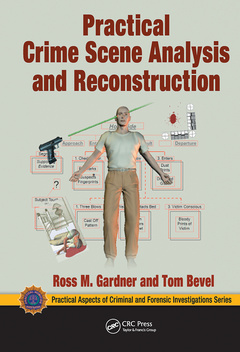Description
Practical Crime Scene Analysis and Reconstruction
Practical Aspects of Criminal and Forensic Investigations Series
Authors: Gardner Ross M., Bevel Tom
Language: English
Subjects for Practical Crime Scene Analysis and Reconstruction:
Keywords
Crime Scene Analysis; Crime Scene; Crime Scene Reconstruction; Event Segments; Crime Scene Analyst; Crime Scene Investigator; Bloodstain Patterns; Crime Scene Processing; Trajectory Rod; Bloodstain Pattern Analysis; Crime Scene Team; Ce Ne; Drip Trail; Livor Mortis; Bullet Defects; Scene Context; DNA Report; Fired Bullet; Spatter Stains; Impact Spatter; Demonstrative Exhibits; Animation Model; Impact Angle; Spatter Event; Cartridge Cases
Publication date: 03-2021
· 17.8x25.4 cm · Paperback
142.05 €
Subject to availability at the publisher.
Add to cartPublication date: 06-2009
302 p. · 17.8x25.4 cm · Hardback
Description
/li>Contents
/li>Readership
/li>Biography
/li>
Crime scene reconstruction (CSR) is today?s hot topic. The immense proliferation of television, print, and electronic media directed at this area has generated significant public interest, albeit occasionally encouraging inaccurate perceptions. Practical Crime Scene Analysis and Reconstruction bridges the gap between perception and reality, helping readers understand the nature of the scientific method and teaching the proper application of its components.
A proven methodology
The book begins by recounting the history of crime scene analysis and exploring fundamental principles. Then the authors introduce their proven methodology, known as Event Analysis. This technique defines specific actions, discusses the order of those actions, and offers significant insight into determining what did or did not happen in the course of the incident under investigation. Using case studies and more than 200 color photos, the book demonstrates this method and how it can be used to explain clues that would otherwise be puzzling or ambiguous.
Practical advice from the crime scene to the courtroom
The authors show how to resolve significant questions that arise in the course of CSR through the use of an event analysis worksheet. The book also discusses crime scene protocol, bloodstain pattern analysis, gunshot investigation, and forensic pathology and the human body. The final chapters provide instruction on writing crime scene reports, discuss ethical issues, and give advice on courtroom presentation.
Includes color photos demonstrating the science of CSR on:
- Superposition
- Timing and sequence
- Bloodstain analysis
- Ballistics
- Wound patterns
An Introduction and History of Crime Scene Analysis. Theoretical and Practical Considerations for Implementing Crime Scene Analysis. Event Analysis: A Practical Methodology for Crime Scene Reconstruction. Resolving Significant Investigative Questions in CSR. Understanding Crime Scene Protocols and Their Effect on Reconstruction. Applying Bloodstain Pattern Analysis to Crime Scene Reconstruction. Shooting Scene Processing and Reconstruction. The Forensic Pathologist, the Body, and Crime Scene Reconstruction. Writing Crime Scene Reconstruction Reports. Arguments and Ethics. Developing and Using Demonstrative Exhibits in Support of the Crime Scene Analysis. Index.
Ross M. Gardner is an active instructor and consultant throughout the United States in crime scene analysis, bloodstain pattern analysis, and crime scene investigation; teaching to a variety of groups ranging from police and investigative organizations to trial counsel professional development groups. Tom Bevel is president of Bevel, Gardner and Associates, Inc., a forensic education and consulting company. He is also an associate professor in the Masters of Forensic Science program at the University of Central Oklahoma, Edmond.




